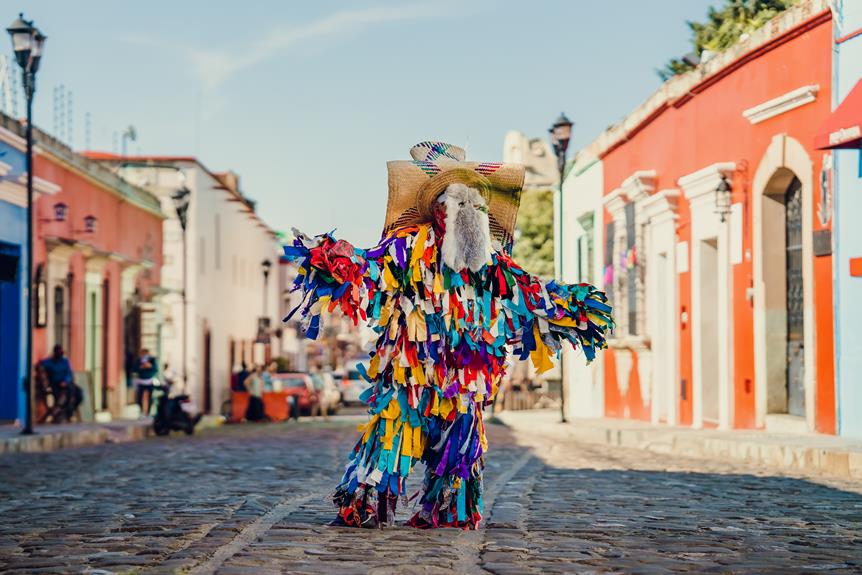
As I immerse myself in the vibrant tapestry of Spanish culture, a kaleidoscope of colors, sounds, and traditions unfold before me. From the rhythmic footwork of traditional dances to the enchanting tales of mythical characters, each aspect of Spanish folklore tells a story. The passion and energy of flamenco music and dance sets my heart ablaze, while the festivals celebrating Spanish cuisine tantalize my taste buds. Join me on this cultural journey as we explore the rich tapestry of festive Spanish folklore.
Key Takeaways
Table of Contents
- Festivals celebrating Spanish cuisine showcase the rich flavors and variety of traditional tapas, as well as the famous Spanish wines like Rioja and Albariño.
- Traditional Spanish dances have a lasting impact on the world stage, with their mesmerizing costumes and fusion of traditional and contemporary styles.
- Mythical characters and legends like the duende, El Cid, and Don Juan are an integral part of Spanish folklore, each with their own unique characteristics and stories.
- Regional folklore celebrations in Spain offer a cultural immersion through elaborate costumes, sacred processions, traditional dances, music, and indulgence in local delicacies specific to each region.
Traditional Spanish Dances
As a dancer, I have always been captivated by the beauty and energy of traditional Spanish dances. One aspect that truly stands out in these dances is the mesmerizing traditional Spanish dance costumes. These costumes are vibrant and flamboyant, often adorned with intricate embroidery and ruffles that add to the overall allure of the performance. The influences of traditional Spanish dances can also be seen in modern culture. From movies to music videos, we witness the incorporation of flamenco-inspired movements and elements of these dances. This fusion of traditional and contemporary styles showcases the lasting impact of Spanish dances on the world stage. It is a testament to the enduring appeal and power of this rich cultural heritage.
Mythical Characters and Legends
I've always been fascinated by the mythical characters and legends that are an integral part of Spanish folklore. From folklore creatures like the duende, a mischievous goblin-like creature, to the famous Spanish legends of El Cid and Don Juan, there is no shortage of captivating stories to explore. The duende, known for its magical powers, is often depicted as a small, elderly man dressed in traditional clothing. It is said to bring good luck or misfortune depending on its mood. El Cid, on the other hand, is a legendary knight who fought against the Moors during the Reconquista. His heroic deeds have been immortalized in literature and film. And of course, who can forget the legendary Don Juan, known for his seductive charm and countless romantic conquests. These mythical characters and legends not only entertain, but also provide a glimpse into the rich cultural heritage of Spain.
Flamenco Music and Dance
Exploring the mythical characters and legends of Spanish folklore, I am now delving into the vibrant world of Flamenco music and dance. Flamenco, with its origins dating back to the 18th century in Andalusia, is a powerful and emotive art form that captivates audiences worldwide. Here are four fascinating aspects of Flamenco that make it truly unique:
- Passionate Expression: Flamenco is known for its intense emotion and raw expression that can be felt through the music and dance. It is a form of self-expression that allows artists to convey their deepest feelings.
- Rhythmic Complexity: The rhythmic patterns in Flamenco are intricate and dynamic, creating a captivating experience for both performers and spectators. The syncopated beats and rapid footwork add to the energetic atmosphere.
- Flamenco Origins: This art form has roots in the diverse cultural influences of the Roma people, Arabs, Jews, and Andalusians. It is a fusion of different traditions and musical styles, giving it a rich and eclectic character.
- Flamenco Costumes: Flamenco dancers are known for their elegant and flamboyant costumes. Women often wear long, flowing dresses with vibrant colors and polka dots, while men opt for tailored suits with a touch of tradition.
Flamenco music and dance are not just performances; they are a window into the soul of Spanish culture, reflecting the passion, history, and diversity of the nation.
Festivals Celebrating Spanish Cuisine
Continuing my exploration of Festive Spanish Folklore, I now delve into the vibrant world of festivals celebrating Spanish cuisine. One of the highlights of these festivals is the traditional Spanish tapas. These small dishes, bursting with flavor and variety, are a beloved part of Spanish culinary culture. At the festivals, you can indulge in an array of tapas, from succulent jamón ibérico to spicy patatas bravas. But it's not just the food that takes center stage; the festivals also celebrate the famous Spanish wines. From the rich and velvety Rioja to the crisp and refreshing Albariño, the festivals offer a chance to savor the diverse flavors of Spanish vineyards. So, grab a plate of tapas, a glass of wine, and immerse yourself in the gastronomic delights of Spanish festivals.
Regional Folklore Celebrations
As I delve into the world of Festive Spanish Folklore, one aspect that captivates me is the regional folklore celebrations. These vibrant and lively events showcase the unique traditions and customs of each region in Spain. Here are some highlights that make these celebrations truly memorable:
- Traditional costume parades: People dress up in elaborate costumes, representing their region's heritage and history. The colorful outfits and intricate designs create a visual spectacle that is a feast for the eyes.
- Sacred processions: These religious processions are an important part of regional folklore celebrations. Communities come together to honor their patron saints, carrying religious statues through the streets accompanied by music and prayers. It is a deeply spiritual and moving experience.
- Traditional dances and music: Each region has its own traditional dances and music, which are performed during these celebrations. From lively flamenco to graceful jotas, these performances showcase the rich cultural heritage of Spain.
- Local delicacies: Regional folklore celebrations are also a chance to indulge in the culinary delights specific to each region. From paella in Valencia to pintxos in the Basque Country, these festivals offer a taste of the diverse gastronomy of Spain.
Exploring these regional folklore celebrations allows you to immerse yourself in the cultural tapestry of Spain and witness the passion and pride that its people hold for their traditions.
Frequently Asked Questions
What Are Some Traditional Spanish Dances Other Than Flamenco?
There are several traditional Spanish dances apart from flamenco. They are an integral part of Spanish folk music and culture. Some examples include sevillanas, jota, sardana, and muñeira. Each dance has its unique style and regional significance.
Are There Any Specific Mythical Characters or Legends Associated With Spanish Folklore?
Oh, Spanish folklore. It's a treasure trove of mythical characters and legends. El Cucuy and La Llorona are just a couple of spooky favorites that will send shivers down your spine.
How Did Flamenco Music and Dance Originate in Spain?
Flamenco music and dance originated in Spain through a fusion of various cultural influences. Its origins can be traced back to the 18th century, blending elements from Andalusian, Moorish, and Romani traditions.
Which Festivals in Spain Celebrate Spanish Cuisine?
Spanish culinary celebrations include traditional food festivals that showcase the rich and diverse cuisine of Spain. These festivals celebrate the country's culinary heritage and offer a chance to indulge in delicious dishes and flavors from different regions.
What Are Some Regional Folklore Celebrations in Spain?
Some regional folklore celebrations in Spain include the Running of the Bulls in Pamplona, the Carnival of Cadiz, and the La Tomatina tomato fight in Valencia. These festivals showcase traditional Spanish culture and bring communities together.




Leave a Reply
You must be logged in to post a comment.